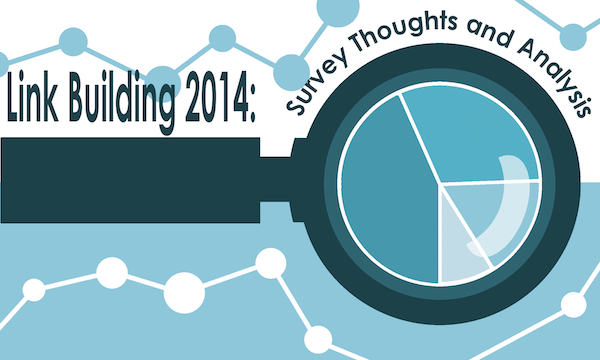James Agate of Skyrocket SEO released the 2014 edition of his link building survey on Moz.
Big hat tip to Agate for his hard work in building the survey along with analyzing and releasing the results. If you haven’t yet had a chance I’d strongly recommend you take the time to read the original post.
Agate has built the data into a visually pleasing infographic as well.
I want to add my own takeaways about the survey and data, and how it all reflects on the SEO industry.
Let’s jump in.
The Interesting Data

A decent amount of data was involved in this survey. To pare it down to what I believe most relevant, here’s a list of interesting data:
- Top Tactics Believed Effective:
- Content and Outreach
- Infographic Promotion
- Guest posts
- Resource Pages
- Competitions/Giveaways/Broken link building/Local citations and business listings
- Most Used Tactics:
- Content and Outreach
- Infographic Promotion
- Broken Link Building
- Local Citation/Business directories
- Resource Pages
- Past 12 Months Investment:
- 81 percent increased investment
- 19 percent decreased investment
- Future 12 Month Investment:
- 73 percent plan to increase
- 27 percent plan to decrease
- Amount Spent Per Month:
- 20 percent spend between $0 and $1,000
- 20 percent spend between $1,000 and $5,000
- 23 percent spend between $5,000 and $10,000
- 37 percent spend between $10,000 and $50,000
- Percentage of SEO Budget:
- 27 percent invested between 0 and 25 percent of their SEO budget into link building
- 27 percent invested between 26 and 50 percent of their SEO budget into link building
- 40 percent invested between 51 and 75 percent of their SEO budget into link building
- 7 percent invested between 76 and 100 percent of their SEO budget into link building
Examining this information and reflecting on my experience in SEO and link building I arrived at five takeaways:
- Link building is getting harder, and there aren’t any shortcuts.
- Links still matter.
- Link tactics change over time, meaning implementing diverse tactics is extremely important.
- If you’re working on your online visibility, links need to be a consideration.
- Link building works best with other online marketing activities.
1. Link Building is Getting Harder – Shortcuts Won’t Work
Link building a few years ago was rife with spammy, low quality, robot-centric activities. Building meaningless links from websites without any human traffic translated to value within search.
That was never Google’s intent, but they didn’t have the algorithmic sophistication to put an end to such practices.
Google’s Penguin algorithm killed the low quality link building arms race. No longer is building mass quantities of low quality links worth pursuing, especially for brands and companies making a long-term investment into online visibility.
Instead, link building is headed into the realm of legitimacy. Into an era of real humans, real editorial votes, hard work, creativity, and sweat.
Now, the only way to build the links that matter is through human connections, a value-added mindset, and an ability to speak convincingly of your own value. In short, the only links worth pursuing are from real websites curated by real people, earned through sweat and creativity.
Every link needs to be earned.
This change is apparent in multiple sections of the survey, including:
- Common reasons for past investment increases
- Future investment increases
- Link building challenges
- Tactics used and tactics believed to be most effective
- Tactics believed to be least effective.
The changes experienced within link building are nearly ubiquitous throughout the entire survey. The shortcuts of the past are fading away, leaving the reality of current link building clear: real links, and real work. And that’s a good thing.
When our livelihood consisted of building a bunch of spammy, irrelevant, low quality links it was hard to take pride in being a link builder. It was hard to be taken seriously. It was hard to defend our industry.
The wheat has been separated from the chaff. Only true professionals remain. The shortcuts have been removed, and those interested in a few quick bucks are moving away.
2. Links Still Matter
The core of Google’s algorithm is still links. Links still are the strongest signal we have to Google about the authority and quality of our content and websites.
This has been confirmed numerous times, including by Google’s Matt Cutts. Just watch this video:
Agate’s 2014 survey confirms that SEO’s continue to believe in the importance of links.
This is represented in a few places throughout the survey:
- The overall percentage of SEO budget being spent on link building.
- The amount of increase invested into link building in the past 12 months.
- The amount of increase planned for link building in the upcoming 12 months.
- Common reasons listed for increases.
This survey is overall good news for link building within SEO. Clearly, SEOs, consultants, business owners, and marketers still see the importance of links within search and continue to invest.
Forty percent of participants within the survey dedicate between 51 and 75 percent of their entire SEO budget into the pursuit of links. That’s without taking into account those who’ve dedicated a portion of their budget to content marketing with a primary goal being links.
If search (and general) online visibility are important to your company, brand, and business, links need to be a concern.
3. Link Tactics Change, Diversity is Important
If there’s one thing constant about SEO, it’s change. SEO is a quickly adapting field, with guidelines, best practices, and considerations changing year after year.
Link building has had a huge disruption in the last few years, and is still experiencing faster than normal change, even for SEO.
The need for diverse tactics is quite apparent within the survey – you need look no farther than second half of the survey, which covers various tactics. Specifically, which tactics are most used, perceived as most effective, and perceived as least effective.
The link tactics perceived as harmful to a site are a perfect example of why diverse tactics are so important. Many of the tactics at the top were commonly used a few short years ago. Cutts recently went on a rant against guest posting, a tactic long considered ironclad safe by many SEOs.
Just look at the repercussions that’s having – Rand Fishkin recently posted about YouMoz being cited as an example of a problem link. In that case, it was because of an overuse of guest blogging with similar anchor text.
If you invest into a single tactic, you’re opening yourself and your business to incredible risk.
Diverse tactics that make strong business sense are incredibly important within link building. As Cutts said this past June at SMX Advanced, “It’s easier to be real, than to fake real.”
Every link building campaign should take into consideration the business, their unique value, their brand, their niche, their audience, and their business goals. Every campaign should be customized to suit the client. And every campaign should include a multitude of tactics that have the potential for real, relevant links.
Placing all your eggs in one basket is a shortcut. Using a single powerful tactic to scale your link building efforts is a shortcut. And Google’s working hard and efficiently to end shortcuts within SEO.
Don’t fall for the trap of working for today. Link building isn’t a once and done project. It requires serious work and ongoing effort. Give links the serious consideration they deserve and invest in the long term. That definitely includes strategic planning and diverse tactics.
4. Online Visibility Efforts Should Consider Links
There are a thousand different ways to build visibility online: PPC, retargeting, email marketing, social media, partnerships, webinars, content marketing, etc.
Due to the efficacy of links online – including navigation, branding, relationships, search visibility – links should be considered within any online marketing activity. Not every activity will directly relate to link building or link acquisition, but if the opportunity exists it’s wasted effort to ignore links.
Search is such a vital source of traffic online. With nearly 6 billion searches per day in 2013 Google has serious influence over the web. Links are the core of their algorithm – building links they value translates to higher visibility.
And since links are the backbone of the web, a sort of online currency, any marketing efforts online have the potential to lead to links. So every online marketing action should have links as a consideration – otherwise valuable marketing equity is left on the table.
This is visible in the survey through a few sections, including common reasons for increases (increased costs moving away from “cheap” link building; good links are just as important as ever), and the amount invested toward link building within SEO budgets.
I genuinely believe that as we see link building and SEO further gain legitimacy online we’ll see more and more marketing and PR firms begin to give greater consideration to links as a valuable commodity online.
Really, it doesn’t matter what you’re doing to improve your online visibility – links need to be a consideration. If they aren’t, you’re missing out.
5. Link Building Works Best With Other Online Marketing Activities
I often think of links as a type of online currency. Cutts referred to links as “your online reputation” at SMX Advanced
The fact is, real links are the result of positive recognition. There are a thousand ways you can earn that recognition – targeted outreach, best in class content, useful resources, establishing a community, building relationships, etc. – but you’ll never get the links you need without finding a way to earn positive recognition.
That’s why link building goes so well with other online marketing activities. Most, if not all, online marketing activities revolve around building positive recognition. Link building is simply leveraging that positive recognition into a desired result: links.
Links still move the needle. This is explicitly stated within the survey and demonstrates that consultants, agencies, business owners, and marketers still believe it to be so.
As an owner of a link building firm I can positively tell you our job is easier when we have something to work with. That doesn’t mean we need content to build links – you can still build links without content – but we need something to work with, be it unique business value, strong brand, solid relationships, influencer attention, etc.
Google’s removed shortcut tactics as an option. Only real links are left. And you can’t build links if you don’t have something to offer.
Recap
The Link Building Survey 2014 edition shows that our industry continues to improve, and that despite general confusion within the SEO industry links continue to matter. It’s great to see these positive trends well represented.
The future of link building looks bright.

This Year’s Premier Digital Marketing Event is #CZLSF
ClickZ Live San Francisco (Aug 11-14) will bring together the industry’s leading online marketing practitioners to deliver 4 days of educational sessions and training workshops. From Data-Driven Marketing to Social, Mobile, Display, Search and Email, the comprehensive agenda will help you maximize your marketing efforts and ROI. Register today!

